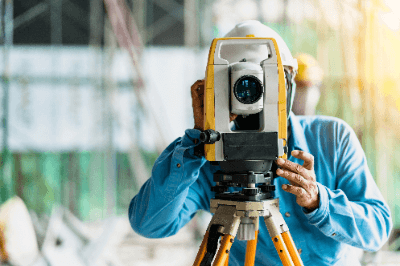What Is a Surveying Instrument?

Surveying is the measurement of distance, height, and extent of land or objects, and surveying instruments are devices used to perform surveying.
Historically, surveying has been used since around 3000 BC in Egypt, where it was used for demarcation after the flooding of the Nile River and for the construction of pyramids. In Japan, the creation of the map of Japan by Tadataka Ino is well known.
There are various types of surveying, including reference point surveying, which determines coordinates based on a reference point, and level surveying, which determines the height of a target (sea level). Surveying instruments are also used to create maps, measure the shape and water level of rivers, and measure buildings.
Uses of Surveying Instruments
As mentioned in the previous section, there are many different types of surveying instruments, depending on the type of surveying work to be performed. Uses of surveying equipment include mapping, measuring rivers and buildings, and measuring land boundaries.
They are also used to create hazard maps for inundation and other hazards by measuring the height of the sea surface and to monitor crustal deformation, such as earthquakes and volcanic eruptions.
Principle of Surveying Instruments
Surveying instruments are used to measure distances, angles (vertical and horizontal angles), and heights (height differences).
A laser-based lightwave rangefinder is used to measure distance, while a theodolite and a scale are used to measure angles (vertical and horizontal angles). The combination of a lightwave rangefinder and theodolite is called a total station, which is widely used in surveying because it can measure oblique distances and angles simultaneously.
A single-element prism target or pin pole prism is used to measure distance, and surveying is done in pairs. There is also a non-prism type that does not use a prism. A laser beam is irradiated onto the object to be measured, and the distance is measured by the reflected laser beam.
Although performance varies depending on the model and object, distances of 500 meters or more can be measured without the use of a prism. Surveying instruments can be used with a prism in the same way as general surveying instruments.
It is characterized by the fact that it can survey even when a prism cannot be installed due to inaccessibility or inaccessibility.
It is also possible to calculate the height difference from the oblique distance and vertical angle, but the instrument height and target height must be taken into account. In addition, the longer the distance measured by a total station, the greater the error.
Another application of surveying instruments is the level, which is used for leveling. There are several types of levels, but generally, auto levels are used. Auto-levels have an automatic correction function and can keep the line-of-sight level as long as it is within the correction range.
Another method is to use the Global Navigation Satellite System (GNSS) to obtain position information. GNSS allows more efficient and quicker surveying over long distances, which is time-consuming and costly with a total station, and in locations that are difficult to survey with conventional surveying.
The use of electronic reference points also eliminates the need for reference point observations required in reference point surveying.
Surveying Regulations
There are two types of surveying: basic surveying and public surveying for which the national government or a public organization bears all or part of the cost and provides assistance.
Public surveying requires notification of the surveyor’s license.
However, some types of surveying, such as building surveying, mapping to less than 1/1,000,000, and surveying to less than the specified accuracy, do not fall under the category of public surveying and do not require notification.
Surveying instruments are also regulated. For example, the first-class theodolite must have a double angle difference of 10″ in horizontal angle and an observation difference of 5″ or less. The rangefinder also needs to be 15 mm or less in comparison to the baseline length for a Class 1 rangefinder. The total station combined with these must meet these standards for angle and distance measurements.
As described above, surveying is a highly public activity, and there are detailed regulations, so those who perform surveying must be aware of these regulations and follow the correct procedures.